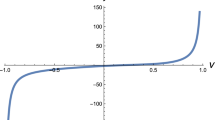Abstract
Let us consider a three-body system with three given pointmasses and let us analyze its bounded solutions with a given angular momentum.
Among these bounded solutions we found the three usual families of elliptic Euler solutions, with collinear central configurations, and a beautiful result would have been the following: ‘The greatest lower bound of the moment of inertia (with respect to the center of masses) for these elliptic Euler solutions is also the greatest lower bound for all bounded solutions of the same masses and angular momentum’.
With the help of a new efficient test of escape we found that the greatest lower bound is always at least 99.9% of the above desired value and we think that the above conjecture is always true.
This new test also leads to many adjacent results and especially, for the present, to the smallest delimitation of the zone of bounded motions.
As other tests ours uses the Jacobi decomposition of the three-body motion with r being the mutual distance of the two masses of the ‘binary’ and R the distance between the center of mass of the binary and the ‘third mass’.
The study is divided into two parts. In the first we analyze the motion of the third mass, its acceleration and its escape velocities when, with a suitable scalar k, a condition of the type r≦kR remains forever satisfied. In the second part we will look for initial conditions under which the inequality r≦kR will remain forever satisfied and we will develop the corresponding test and its applications.
Similar content being viewed by others
References
Birkhoff, G. D.: 1927, ‘Dynamical Systems’, American Mathematical Society, Providence, R.I.
Bozis, G.: 1976,Astrophysics and Space Sciences 43, 355.
Chen Xiang-Yan, Sun Yi-Sui, and Luo Din-Jun: 1978,Acta Astronomica Sinica 19, 119 andChinese Astronomy 3, 223.
Easton, R.: 1971,Journal of Differential Equations 10 371.
El Mabsout, B.: 1973,Comptes Rendus de l'Académie des Sciences A276 495.
Golubev, V. G.: 1968,Soviet Phys. Dokl. 13, 373.
Marchal, C.: 1971,Astronomy and Astrophysics 10, 278.
Marchal, C. and Saari, D. G.: 1975,Celest. Mech. 12, 115.
Marchal, C. and Bozis, G.: 1982,Celest. Mech. 26, 311.
Smale, S.: 1970,Inventiones Math. 11, 45.
Sundman, K. F.: 1912,Acta Matematica 36, 105.
Szebehely, V. and McKenzie, R.: 1977,Astron. Journal 82, 79.
Szebehely, V. and Zare, K.: 1977,Astron. Astrophysics 58, 145.
Tung Chin-Chu: 1974,Scienta Sinica 17 306.
Zare, K.: 1976,Celest. Mech. 14, 73.
Zare, K.: 1977,Celest. Mech. 16, 35.
Author information
Authors and Affiliations
Rights and permissions
About this article
Cite this article
Marchal, C., Yoshida, J. & Yi-Sui, S. A test of escape valid even for very small mutual distances I. The acceleration and the escape velocities of the third body. Celestial Mechanics 33, 193–207 (1984). https://doi.org/10.1007/BF01230502
Received:
Accepted:
Issue Date:
DOI: https://doi.org/10.1007/BF01230502




